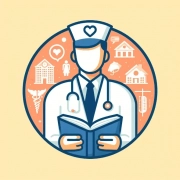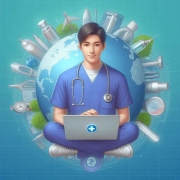NURS FPX 5003 Interview of Health Care Professional Essay Example
 NURS FPX 5003 Assessment 2 Interview of Health Care Professional
NURS FPX 5003 Assessment 2 Interview of Health Care Professional
Assignment Brief: NURS FPX 5003 Interview of Health Care Professional
Course: NURS FPX 5003 Health Assessment and Promotion for Disease Prevention in Population-Focused Health
Assignment Title: Assessment 2 Interview of Health Care Professional
Assignment Overview:
In this assignment, you will conduct an interview with a healthcare professional to explore strategies for addressing healthcare disparities and promoting health equity. By gaining insights from the experiences and perspectives of healthcare experts, you will analyze the challenges faced in delivering culturally and linguistically appropriate services and identify strategies to overcome these barriers.
Understanding Assignment Objectives:
The primary objective of this assignment is to deepen your understanding of healthcare disparities and the importance of providing culturally competent care. By conducting an interview with a healthcare professional, you will gain firsthand insights into the strategies employed to address the healthcare needs of diverse populations. Additionally, you will analyze the role of the National CLAS Standards in promoting health equity and reducing disparities in healthcare delivery.
The Student’s Role:
As a student, your role is to prepare for and conduct an interview with a healthcare professional. You will formulate thoughtful questions that delve into the challenges and strategies associated with addressing healthcare disparities. During the interview, you will actively listen to the insights shared by the healthcare professional and ask follow-up questions to gain a deeper understanding of the topic. After the interview, you will analyze the key findings and reflect on their implications for promoting health equity and improving patient outcomes.
NURS FPX 5003 Interview of Health Care Professional Essay Example
Introduction
Interviewing healthcare professionals is a valuable method for gaining insights into the healthcare needs of diverse populations served by healthcare organizations. By blending real-world experiences with healthcare data, we can create more effective strategies and plans. Understanding how healthcare professionals communicate with patients, particularly those from different racial and ethnic backgrounds, is crucial for providing them with the necessary health information for making informed decisions.
Additionally, healthcare professionals can contribute to refining best practices by observing the work of industry leaders. Implementing these best practices ensures adherence to relevant standards and guidelines in healthcare. This paper explores the key findings from an interview with Dr. Mud Swamp, who oversees various health programs at West Virginia College on this subject. Dr. Swamp’s insights shed light on strategies for addressing healthcare needs, evaluating interventions, and adhering to National CLAS Standards.
Strategies for Addressing Healthcare Needs
To understand a community’s healthcare needs, different methods can be used, like talking to healthcare professionals, meeting with community leaders, conducting surveys, and analyzing demographic data. Aron (2019) points out that the Plan-Do-Study-Act (PDSA) cycle is a helpful tool for improving organizations. In healthcare, this cycle helps to check if care quality is good and if any changes are needed. External evaluators can help organizations plan changes and see if they work.
Healthcare disparities still exist in the United States, where certain groups, like sexual, ethnic, and gender minorities, and people with low health literacy, often get lower-quality care (NHS England and NHS Improvement, 2021). The Cultural and Linguistically Appropriate Services (CLAS) standards were introduced in 2000 to tackle these disparities. In 2013, better National CLAS standards were made to help healthcare organizations make sure everyone gets fair healthcare, especially minority groups with low health literacy. To provide CLAS, healthcare providers need to be culturally sensitive and competent (Minority Health, n.d.).
Criteria for Evaluating Strategies
To assess how well strategies work, organizers should ask questions like “What did the organization achieve in this time?” “How many diabetic patients were helped?” and “What challenges actually helped the program work better?” Dineen-Griffin et al. (2019) suggest that healthcare groups can hire someone from outside or use their own staff to check how well their systems work and plan for the future. The Organization for Economic Co-operation and Development (OECD) DAC has six criteria for evaluation: relevance, soundness, effectiveness, efficiency, impact, and sustainability, and two principles to use them (Alcayna and O’Donnell, 2022).
According to the interview, West Virginia College hospitals use different ways to give Culturally and Linguistically Appropriate Services (CLAS) to diabetic patients. They use a patient-centered way of talking and deal with cultural problems in care. To make sure the care team and patients work well together, the care follows the Chronic Care Model (Timpel et al., 2020).
Healthcare professionals can talk with the care team, patients, and communities in different ways, like groups, meetings, campaigns, and surveys (Gehlert et al., 2019). Patient outcomes can get better when complex health info is talked about in a good way to different patients. For example, it’s better to explain to diabetic patients why keeping their blood sugar level right is so important to stop problems like amputation and nerve or kidney issues, instead of just telling them what the level should be. By knowing more about people with low health knowledge, the problems of talking to people at risk, and the best ways to help, healthcare workers can make a plan to make health education better.
Benefits of Adhering to National CLAS Standards
The National CLAS Standards provide a structured approach for delivering healthcare services that honor patients’ preferences and communication needs, ensuring cultural and linguistic appropriateness. By adhering to these standards, healthcare providers can enhance their ability to operate effectively in diverse environments, which in turn helps in reducing healthcare disparities and promoting health equity. These standards facilitate healthcare professionals in learning from patients with diverse perspectives and beliefs, fostering openness to their thoughts and creating connections with their backgrounds (Annalee A, 2022).
On the other hand, epidemiological principles serve as the foundation for disease surveillance and analysis conducted by public health experts. These principles concentrate on understanding the root causes of public health issues and diseases, as well as identifying the most effective treatments, interventions, and solutions. Epidemiologists utilize research and statistical analysis to track diseases and forecast their impact on the population. They also utilize demographic characteristics such as age, economic status, gender, and race/ethnicity to identify groups at risk for specific health outcomes.
The main objective of epidemiology is to describe the occurrence of diseases and recognize disparities in disease occurrence across different groups. To assess the burden of diseases, epidemiologists rely on specific terms such as frequency, expected impact, and survival measures (Harvard Medical School, 2022).
Organization’s Strengths in Addressing National CLAS Standards
The dedication of West Virginia College Hospital to implementing and following the National CLAS Standards has resulted in significant strides in addressing healthcare disparities and meeting the needs of vulnerable populations, such as the African American community. Achieving success in implementing these standards requires strong commitment from the organization. The National CLAS Standards have played a role in increasing awareness about the importance of providing culturally and linguistically appropriate services (U.S. Department of Health & Human Services, 2022). By serving as a model for other healthcare institutions, the National CLAS Standards aim to promote clinical prevention and reduce healthcare disparities.
The gap between recommended healthcare practices and the actual care provided to patients is referred to as a healthcare gap. When healthcare providers fail to adhere to key aspects of the CLAS standards, such as treating all patients equally, respecting patients’ cultural health beliefs, or addressing language barriers, gaps in meeting the standards may arise. Medical errors and a lack of transparency can also contribute to these gaps. Both patients and payers, such as self-insured employers, face quality issues when care gaps exist (Yip et al., 2019). Understanding cultural competence allows for a deeper appreciation of how identity, culture, and education influence the way diverse populations in West Virginia perceive, accept, and make informed decisions based on reliable health information.
Challenges of Organization in Addressing National CLAS Standards
Implementing the National CLAS Standards poses several challenges for organizations. One challenge is the need for extra resources and guidance to understand and apply the standards effectively. Failing to implement these standards can result in negative outcomes for patients and financial burdens due to errors that the standards could prevent. Inconsistencies in accountability measures and communication problems within healthcare organizations can also hinder effective implementation of the National CLAS Standards, as noted in a study by Isoherranen et al. (2019). Additionally, if nursing staff are not proficient in the local language, they may face significant communication barriers when interacting with local patients.
Lack of resources can also pose difficulties for organizations in accurately assessing and meeting the standards. Recruiting skilled professionals, collecting data on different racial groups, and providing training to existing staff incur additional costs for the organization (Think Cultural Health, n.d.). Furthermore, limited access to primary healthcare services in rural areas can further impede efforts to address the National CLAS Standards.
Organization’s Strategies, Strengths, and Weaknesses
In healthcare, effective communication is vital for patient well-being. At West Virginia College Hospital, efforts are made to empower staff to communicate openly and make necessary adjustments to meet CLAS standards, ensuring clear and accurate information exchange. Staff actively listen to patients, enhancing communication by creating internal communication strategies, as suggested by Rangachari and Woods (2020), who emphasize the importance of face-to-face interactions in patient-provider communication.
Irrespective of patients’ backgrounds, the hospital staff values their input, recognizing the significance of integrating patient preferences into treatment decisions. This inclusive approach distinguishes the organization, as staff members understand and respect diverse cultural perspectives, tailoring patient inquiries and treatment plans accordingly. Embracing diversity in healthcare fosters cultural competence among providers, aligning with the CLAS standards (Spitzer-Shohat & Chin, 2019).
Gomez and Bernet (2019) highlight additional strategies employed at WVU Hospital, such as embracing diverse cultures and using precise language, which can present constructive challenges.
However, a weakness lies in the retooling process, as new staff may require additional training to use current tools and equipment, posing a financial burden. Despite this, WVU Hospital seizes the opportunity to educate healthcare workers on cutting-edge medical technology, introducing new services to enhance healthcare delivery.
Conclusion
In conclusion, identifying healthcare needs through various strategies facilitates the prioritization of resources, addressing healthcare disparities, and enhancing healthcare delivery. This process fosters collaboration and creativity while engaging the target audience in meaningful ways. Furthermore, interviews with healthcare professionals like Dr. Swamp offer invaluable insights into addressing healthcare needs and promoting equity. Prioritizing cultural competence, effective communication, and adherence to National CLAS Standards are pivotal in bridging disparities and improving patient outcomes. Through these concerted efforts, healthcare organizations can strive towards achieving health equity and ensuring better healthcare access and outcomes for all.
References
Alcayna, T., & O’Donnell, D. (2022). How much global climate adaptation finance is targeting the health sector? European Journal of Public Health, 32(Supplement_3). https://doi.org/10.1093/eurpub/ckac129.146
Annalee A., M. (2022). A culturally competent patient care: A review of the CLAS standards. International Archives of Public Health and Community Medicine, 6(2). https://doi.org/10.23937/2643-4512/1710077
Aron, D. C. (2019). The complexity of context. Complex systems in medicine, 101–114. https://doi.org/10.1007/978-3-030-24593-1_9
Barksdale, C. L., Rodick, W. H., Hopson, R., Kenyon, J., Green, K., & Jacobs, C. G. (2016). Literature review of the national CLAS standards: Policy and practical implications in reducing health disparities. Journal of Racial and Ethnic Health Disparities, 4(4), 632–647. https://doi.org/10.1007/s40615-016-0267-3
Dineen-Griffin, S., Garcia-Cardenas, V., Williams, K., & Benrimoj, S. I. (2019). Helping patients help themselves: A systematic review of self-management support strategies in primary health care practice. PLOS ONE, 14(8). https://doi.org/10.1371/journal.pone.0220116
Gehlert, S., Choi, S. K., & Friedman, D. B. (2019). Communication in health care. Handbook of health social work, 249–277. https://doi.org/10.1002/9781119420743.ch12
Gomez, L. E., & Bernet, P. (2019). Diversity improves performance and outcomes. Journal of the National Medical Association, 111(4), 383–392. https://doi.org/10.1016/j.jnma.2019.01.006
Harvard Medical School (2022). Using epidemiological tools to evaluate human disease. Postgraduateeducation.hms.harvard.edu. https://postgraduateeducation.hms.harvard.edu/trends-medicine/using-epidemiological-tools-evaluate-human-disease
Hegazy, M., Elsayed, N. M., Ali, H. M., Hassan, H. G., & Rashed, L. (2019). Diabetes Mellitus, nonalcoholic fatty liver disease, and conjugated linoleic acid (Omega 6): What Is the Link? Journal of Diabetes Research, 2019, 1–7. https://doi.org/10.1155/2019/5267025
Isoherranen, K., O’Brien, J. J., Barker, J., Dissemond, J., Hafner, J., Jemec, G. B. E., Kamarachev, J., Läuchli, S., Montero, E. C., Nobbe, S., Sunderkötter, C., & Velasco, M. L. (2019). Atypical wounds: Best clinical practice and challenges. Journal of Wound Care, 28(Sup6), S1–S92. https://doi.org/10.12968/jowc.2019.28.sup6.s1
Minority Health (n.d). CLAS, cultural competency, and cultural humility. https://www.minorityhealth.hhs.gov/Assets/PDF/TCH%20Resource%20Library_CLAS%20CLC%20CH.pdf
NHS England and NHS Improvement. (2021). Plan, Do, Study, Act (PDSA) Cycles and the Model for Improvement Online Library of Quality, Service Improvement and Redesign Tools NHS England and NHS Improvement. https://www.england.nhs.uk/wp-content/uploads/2022/01/qsir-pdsa-cycles-model-for-improvement.pdf
Rangachari, P., & L. Woods, J. (2020). Preserving organizational resilience, patient safety, and staff retention during COVID-19 requires a holistic consideration of the psychological safety of healthcare workers. International Journal of Environmental Research and Public Health, 17(12), 4267. https://doi.org/10.3390/ijerph17124267
Spitzer-Shohat, S., & Chin, M. H. (2019). The “Waze” of inequity reduction frameworks for organizations: a scoping review. Journal of general internal medicine, 34(4), 604–617. https://doi.org/10.1007/s11606-019-04829-7
Think Cultural Health. (n.d.). Summary of key findings. https://thinkculturalhealth.hhs.gov/assets/pdfs/clas-ncs-evaluation-project.pdf
Timpel, P., Lang, C., Wens, J., Contel, J. C., Schwarz, P. E. H., & CARE study group, On behalf of the M. (2020). The Manage Care Model – Developing an evidence-based and expert-driven chronic care management model for patients with diabetes. International Journal of Integrated Care, 20(2), 2. https://doi.org/10.5334/ijic.4646
U.S. Department of Health & Human Services. (2022). CLAS Standards. Think Cultural Health. https://thinkculturalhealth.hhs.gov/clas/standards
West Virginia University. (n.d.). Chancellor | Health Sciences | Vp.hsc.wvu.edu. Retrieved January 21, 2023, from https://vp.hsc.wvu.edu/
Yip, W., Fu, H., Chen, A. T., Zhai, T., Jian, W., Xu, R., Pan, J., Hu, M., Zhou, Z., Chen, Q., Mao, W., Sun, Q., & Chen, W. (2019). 10 years of health-care reform in China: progress and gaps in Universal Health Coverage. The Lancet, 394(10204), 1192–1204. https://doi.org/10.1016/S0140-6736(19)32136-1
Boost Your Grades with Our Expert Nursing Paper Writing Services & Stay Ahead of Your Classmates!
Struggling with complex nursing assignments? Feeling overwhelmed by the demands of nursing research papers? Look no further! At ReliablePapers.com, we are your trusted companion in the journey towards academic excellence. Our team of seasoned nursing essay writers is dedicated to writing custom-made and original nursing papers that guarantee top-notch grades.
Why Choose ReliablePapers.com’s Nursing Writing Services?
- Expert Nursing Writers: Our skilled writers possess years of experience and expertise in crafting tailored nursing papers. From research papers to assignments, we ensure excellence in every paper, helping you secure the grades you deserve.
- Affordable Prices: Worried about your budget? Our online nursing papers come at prices that are accessible to all college students. Quality and affordability are at the core of our service.
- Originality Guaranteed: Plagiarism is a thing of the past. Our nursing experts create original and customized essays, ensuring your academic success without compromising integrity.
- Timely Support: Tight deadlines? No problem! We excel in providing timely support, helping you submit your assignments promptly and alleviate the stress of impending deadlines.
How Our Professionals Can Assist You to Stay Ahead of Your Classmates
Our pro nursing writers excel in creating outstanding papers from scratch, addressing any topic, meeting any deadline, and adhering to your specific instructions. From nursing research papers to assignments, we’ve got you covered. Trust ReliablePapers.com to help you excel in your nursing studies and achieve academic success.
Why Trust Our Professionals?
At ReliablePapers.com, we stay updated with the latest nursing trends and guidelines, ensuring standout research papers that impress your professors. Balancing assignments and class participation can be challenging, but with our nursing writing help, you can navigate through your academic journey with confidence.
Secure Top Grades, Save Time: Order Your Nursing Essays Today!
Don’t let stress hinder your success. Visit our “Place Order” page, fill in your requirements, and trust us to make your nursing papers perfect. ReliablePapers.com is not just a writing service; it’s your partner in academic excellence. Order now and experience the best in custom nursing coursework writing!
Hire an Expert Paper Writer on Any Subject, Any Topic, Any Deadline! Submit your paper instructions by placing your order here to get started!


 NURS FPX 5003 Assessment 1 Identifying Community Health Needs
NURS FPX 5003 Assessment 1 Identifying Community Health Needs NURS FPX 8014 Assessment 3: Leading Global Health Strategic Planning and Policy Development Notes
NURS FPX 8014 Assessment 3: Leading Global Health Strategic Planning and Policy Development Notes NURS FPX 8014 Assessment 2 Global Issue Problem Description
NURS FPX 8014 Assessment 2 Global Issue Problem Description NURS FPX 8014 Assessment 1 Nongovernmental Agency Involved in Global Issues
NURS FPX 8014 Assessment 1 Nongovernmental Agency Involved in Global Issues NHS FPX 4000 Assessment 4: Analyze a Current Health Care Problem
NHS FPX 4000 Assessment 4: Analyze a Current Health Care Problem NURS FPX 4000 Assessment 2: Applying Research Skills
NURS FPX 4000 Assessment 2: Applying Research Skills NURS FPX 4010 Assessment 4: Stakeholder Presentation Example Assignment
NURS FPX 4010 Assessment 4: Stakeholder Presentation Example Assignment NURS FPX 4010 Capella 4010 Assessment 3: Interdisciplinary Plan Proposal
NURS FPX 4010 Capella 4010 Assessment 3: Interdisciplinary Plan Proposal NURS FPX 4010 Assessment 1: Collaboration and Leadership Reflection Video
NURS FPX 4010 Assessment 1: Collaboration and Leadership Reflection Video